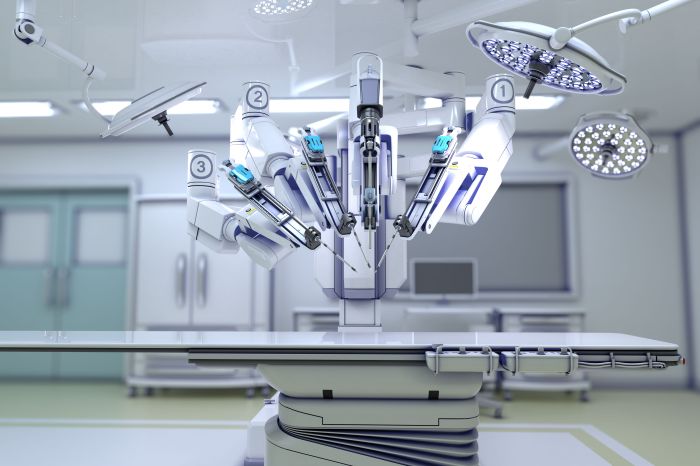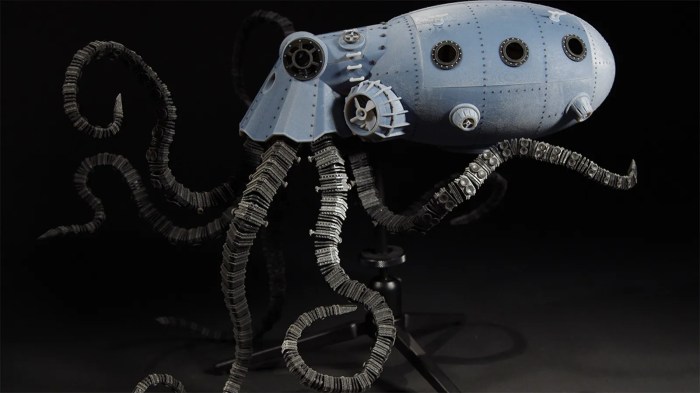Robot inspired by octopus could end up performing surgery – Imagine a future where surgeries are performed by robots with the dexterity and adaptability of an octopus. This isn’t science fiction; it’s a rapidly developing field of research with the potential to revolutionize healthcare. Octopus-inspired robotics is capturing the attention of scientists and engineers, as they unlock the secrets of these fascinating creatures to create surgical tools that could surpass anything we’ve seen before.
The octopus, with its unique anatomy and incredible abilities, offers a blueprint for a new generation of surgical robots. These robots could navigate complex and confined spaces with ease, making them ideal for minimally invasive procedures. The octopus’s flexible body, multiple arms, and suction cups provide inspiration for designing robotic limbs that can grasp, manipulate, and control tools with unprecedented precision.
Octopus-Inspired Robotics
The realm of surgical robotics is constantly evolving, driven by the pursuit of minimally invasive procedures and enhanced precision. Inspired by the remarkable capabilities of octopuses, a new wave of surgical robots is emerging, promising groundbreaking advancements in the field. The octopus, with its flexible body, multiple arms, and suction cups, offers a blueprint for designing robots that can navigate complex surgical environments with unprecedented dexterity and control.
Octopus Anatomy and Surgical Applications
The octopus’s unique anatomy provides a rich source of inspiration for surgical robotics. Its flexible body allows it to squeeze through tight spaces, its eight arms provide multiple points of contact and manipulation, and its suction cups enable it to grasp and manipulate delicate tissues with precision. These characteristics translate directly into desirable features for surgical robots.
- Flexibility: The octopus’s boneless body allows it to contort itself into various shapes, enabling it to reach confined areas within the human body. This flexibility is crucial for minimally invasive surgeries, where surgeons need to operate through small incisions. Robotic arms inspired by the octopus’s anatomy can be designed with multiple joints and segments, allowing them to bend and twist in ways that conventional robotic arms cannot.
- Multiple Arms: The octopus’s eight arms provide a high degree of dexterity and manipulation capability. This feature can be replicated in surgical robots by designing multiple robotic arms that can work independently or in coordination. These arms can be equipped with specialized tools, such as forceps, scalpels, and cameras, to perform complex surgical tasks.
- Suction Cups: The octopus’s suction cups provide a strong grip and allow it to manipulate objects with precision. In surgical robots, suction cups can be used to grasp and manipulate delicate tissues without causing damage. They can also be used to secure instruments in place during surgery.
Examples of Octopus-Inspired Robots
Several researchers and companies are developing octopus-inspired robots for surgical applications.
- Octobot: Developed by researchers at Harvard University, Octobot is a soft robot made of silicone that can move and interact with its environment using a network of air channels. This robot is still in its early stages of development, but it demonstrates the potential of soft robotics for surgical applications.
- The “Octopus Arm”: This robot, developed by researchers at the University of California, Berkeley, is a flexible robotic arm inspired by the octopus’s anatomy. The arm is made of a series of interconnected segments that can bend and twist in multiple directions. The researchers envision using this arm to perform minimally invasive surgeries, particularly in areas that are difficult to access with traditional surgical tools.
Advantages of Octopus-Inspired Robots in Surgery
The development of surgical robots has revolutionized minimally invasive surgery, but there is always room for improvement. Traditional surgical robots, often modeled after human arms, have limitations in dexterity and adaptability. Octopus-inspired robots, on the other hand, offer a new paradigm, leveraging the unique capabilities of these cephalopods to address these shortcomings.
Increased Dexterity and Manipulation
Octopus-inspired robots have the potential to significantly enhance surgical dexterity. The octopus’s flexible, multi-jointed arms, coupled with its ability to independently control each sucker, allows for unparalleled precision and control in manipulating objects. Traditional surgical robots, with their rigid arms and limited degrees of freedom, struggle to navigate complex anatomical spaces and perform intricate procedures. Octopus-inspired robots, with their soft, flexible arms and numerous degrees of freedom, can access difficult-to-reach areas and perform delicate tasks with greater ease.
“Octopus-inspired robots can achieve a higher level of dexterity compared to traditional surgical robots, allowing for more precise and controlled manipulation of tissues and instruments.”
Adaptability and Flexibility, Robot inspired by octopus could end up performing surgery
The octopus’s remarkable adaptability is another key advantage in the surgical context. Its arms can contort and squeeze through tight spaces, allowing it to navigate complex anatomical structures without causing damage. Traditional surgical robots, with their rigid arms and limited articulation, are often restricted in their movement, requiring multiple incisions for access. Octopus-inspired robots, with their inherent flexibility, can access surgical sites through a single incision, minimizing trauma and reducing recovery time.
Precision and Control
Octopus-inspired robots can potentially achieve a level of precision that surpasses traditional surgical robots. The octopus’s ability to independently control each sucker provides exceptional fine motor control, allowing for delicate manipulations of tissues and instruments. This level of precision is particularly valuable in delicate surgeries, such as neurosurgery and ophthalmology, where even slight movements can have significant consequences.
“The octopus’s unique sucker-based manipulation system allows for precise control and dexterity, potentially leading to improved surgical outcomes.”
Addressing Current Limitations in Minimally Invasive Surgery
Octopus-inspired robots can address several limitations of current minimally invasive surgery techniques. The inherent flexibility of these robots allows them to access surgical sites through smaller incisions, reducing the risk of complications and improving patient recovery. Their adaptability and dexterity allow for more complex procedures to be performed minimally invasively, expanding the scope of minimally invasive surgery.
“Octopus-inspired robots have the potential to revolutionize minimally invasive surgery, offering greater precision, flexibility, and adaptability, leading to improved patient outcomes.”
Applications of Octopus-Inspired Robots in Surgery: Robot Inspired By Octopus Could End Up Performing Surgery
Octopus-inspired robots, with their remarkable dexterity and adaptability, hold immense potential to revolutionize various surgical procedures. These robots, designed to mimic the octopus’s unique anatomical features, can navigate complex and confined spaces with ease, offering significant advantages over traditional surgical tools.
Laparoscopic Surgery
Laparoscopic surgery, a minimally invasive technique that involves small incisions and specialized instruments, benefits greatly from the dexterity of octopus-inspired robots. These robots can manipulate surgical instruments with precision and control, allowing surgeons to perform intricate procedures with minimal trauma to the patient. For example, in laparoscopic cholecystectomy (gallbladder removal), the octopus-inspired robot’s flexible arms and grasping capabilities can maneuver around delicate organs, ensuring precise removal of the gallbladder while minimizing the risk of damage to surrounding tissues.
Neurosurgery
Neurosurgery, dealing with the intricate structures of the brain and spinal cord, requires exceptional precision and control. Octopus-inspired robots, with their ability to navigate tight spaces and manipulate instruments with finesse, are well-suited for delicate neurosurgical procedures. For instance, in brain tumor removal, the robot’s flexible arms can reach deep into the brain, allowing surgeons to remove tumors with minimal damage to surrounding healthy tissue. This enhanced precision can lead to improved outcomes and reduced complications.
Ophthalmic Surgery
Ophthalmic surgery, involving the delicate structures of the eye, requires exceptional precision and control. Octopus-inspired robots, with their nimble movements and dexterity, can perform intricate procedures with minimal trauma to the eye. For example, in cataract surgery, the robot’s flexible arms can manipulate instruments with precision, allowing surgeons to remove the clouded lens and implant a new one with minimal risk of damage to the surrounding structures.
Hypothetical Scenario
Imagine a complex surgical procedure to repair a damaged blood vessel in the brain. Traditional surgical techniques would require a large incision and a lengthy recovery period. However, an octopus-inspired robot, with its flexible arms and miniature surgical tools, could navigate through a small incision, reaching the damaged blood vessel with ease. The robot’s dexterity would allow surgeons to repair the vessel with precision, minimizing the risk of complications and shortening the recovery time.
Challenges and Future Directions
While the potential of octopus-inspired robots in surgery is exciting, several challenges and ethical considerations need to be addressed before widespread adoption. This section explores the technological hurdles, potential ethical concerns, and future research directions in this field.
Technological Challenges
Developing and implementing octopus-inspired surgical robots presents significant technological challenges. These challenges stem from the complex nature of octopus anatomy and the need to translate their unique capabilities into a functional robotic system.
- Mimicking Octopus Dexterity: Replicating the octopus’s exceptional dexterity and manipulation skills in a robotic system is a major challenge. This requires advanced control algorithms, sophisticated sensors, and innovative actuator designs to achieve the octopus’s remarkable agility and precision.
- Soft Robotics and Material Science: Creating soft, flexible robotic arms that can navigate delicate surgical environments is a significant hurdle. Current research focuses on developing biocompatible and adaptable materials for these robots, ensuring safety and effectiveness during surgery.
- Control and Autonomy: Developing intuitive and reliable control systems for octopus-inspired robots is crucial. These robots need to be responsive to surgeon commands while also exhibiting a degree of autonomy for navigating complex anatomical structures.
- Integration with Existing Surgical Equipment: Seamless integration of octopus-inspired robots with existing surgical equipment and workflows is essential for their successful adoption in hospitals and clinics.
Ethical Considerations
The use of octopus-inspired robots in surgery raises several ethical considerations. Addressing these concerns is vital to ensure responsible and ethical implementation of this technology.
- Patient Safety: Ensuring the safety of patients during surgery is paramount. Rigorous testing and validation of octopus-inspired robots are crucial to demonstrate their efficacy and minimize potential risks.
- Transparency and Informed Consent: Patients must be fully informed about the use of octopus-inspired robots in their surgeries, including potential benefits, risks, and alternatives. Informed consent procedures must be clear and comprehensive.
- Job Displacement: The potential impact of octopus-inspired robots on surgical jobs is a concern. Careful consideration of workforce training and transition strategies is necessary to mitigate any negative consequences.
- Privacy and Data Security: The use of robots in surgery raises concerns about patient data privacy and security. Robust measures must be implemented to protect sensitive medical information.
Future Research Directions
The field of octopus-inspired surgical robotics holds immense promise. Ongoing research and development efforts aim to overcome current challenges and unlock the full potential of this technology.
- Advanced Materials and Actuators: Further research into soft, biocompatible materials and actuators is crucial for developing more sophisticated and functional octopus-inspired robots.
- Improved Control and Autonomy: Developing more advanced control algorithms and autonomous navigation capabilities will enhance the precision and safety of these robots.
- Clinical Trials and Validation: Conducting rigorous clinical trials is essential to demonstrate the safety and efficacy of octopus-inspired robots in real-world surgical settings.
- Human-Robot Interaction: Research on intuitive and user-friendly human-robot interfaces is vital to ensure seamless collaboration between surgeons and octopus-inspired robots.
The potential of octopus-inspired robots in surgery is immense. These robots could not only improve the safety and effectiveness of procedures but also open up new possibilities for minimally invasive surgery. As researchers continue to push the boundaries of robotic design, we can expect to see increasingly sophisticated and capable robots inspired by the octopus, transforming the future of healthcare.
 Standi Techno News
Standi Techno News

